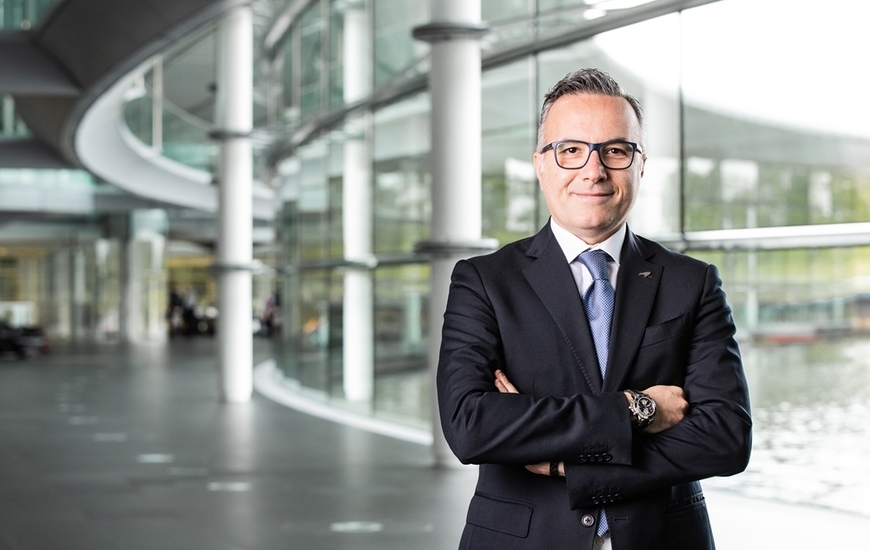by NICOLA CATENARO
Composites Portal and Portale Compositi continue the investigation to discover the future of composites. On this topic we interviewed Luciano De Oto, McLaren's Body Engineering Director. Here's what he replied.
Is there still, today, a close relationship between composite materials and innovation in the automotive sector?
«Yes definitely. Carbon fiber will play a key role in automotive in the future, thanks to all innovations currently at research or advanced TRL (Technology Readiness Level) status. The bulk of these innovation will come from nanocomposites applications, for instance batteries embedded in carbon body panels, BIW structures able to detect any damages from low speed impacts, intelligent rims interacting with the vehicle, but also the automation will play a relevant role, reducing CFRP manufacturing times and costs».
If the electric solutions will continue to develop, will we see carbon fiber cars going around the streets in your opinion?
«In our SuperSport segment for sure but in automotive in general still to come. Electrification is in fact heavily impacting our business and, despite the revolution in car architecture, we’ll always be measured on performances base, such as lap times, handling and so on. Here the weight plays a key role. The incremental weight given by the electrification must be then offset by a correspondent weight reduction on body components. Different is the story with lower segments, when the costs are not yet in an affordable range for the OEMs».
Are there materials that could replace composites in terms of lightness and strength?
«Yes, graphene appears to be the most promising one… is one of the most important nanomaterials and has attracted our attention due to its extraordinary mechanical properties, notable flexibility, excellent electronic transport performances such as extremely high electric conductivity, high thermal conductivity, good stability against chemicals and high temperatures, and valuable others. Graphene is on the market right now. Monolayers GO and rGO are at prices that make great sense when looking at a cost benefit analysis. However, costs are still prohibitive but the trend in the last two years shows already a reduction by 70%!».
Creativity or technique? What weighs more on your work?
«Both are relevant and have to be present in our work. Good manager is able to allocate right talents to the right job, same as a football team. Concept and Predevelopment phases require more creativity and ingenuity, whilst the Core engineering phase is more for technical oriented people, with a more methodical approach».
How much has Covid changed the forecasts for the future of the automotive sector and in particular of the supercar market?
«COVID’s impact has been hard to the automotive market. All main OEMs have been forced in the best cases to downsize 5-years product plans and, in the worst cases, to fire large numbers of employees due to important reduction of new products to be developed. Luxury goods world was the one paying the highest price, as it was deemed inessential and the outlook to come back to pre-COVID numbers says an average of 3 years from now».
What is the most important challenge that the automotive industry will have to overcome in the future?
«For sure the pressure from environmentalists and governmental regulations will increase, hence we are forced to continuously work to decrease CO2 emissions from our new models, which will increases our prices and decreases our performances. In the same time, we have heavily to invest in developing electrification to stay in business whilst the stranglehold of CO2 regulations tightens around our neck and only the big players will have significant role in that field. China will be an important factor as well, as is losing share in a rapidly growing due to COVID situation and the commercial dispute with the U.S. Last challenge for us will be the connected car. This will change the car industry forever. Cars that drive and interact with each other without human participation will completely change the way people travel. The OEM that first achieves this will have the chance to become the dominant force in the car market for decades to come».
_____________
Luciano De Oto joined McLaren in 2019 as Body Engineering Director. He worked before for Automobili Lamborghini from 2001 as BIW engineer for Gallardo, then as Manager for the interiors and exteriors Engineering and Development, for all Lamborghini products, such as the 2007 Gallardo Superleggera and the Aventador, developing the complete monocoque as well. In 2010 the remarkable VI Elemento which was a true landmark for the Company and then the Huracàn Coupe and Perfomante, presenting for the first time in Automotive the application of SMC carbon for visual application.
De Oto was also in Ferrari Formula 1 as Junior Aerodynamicist from 1999 to 2001, contributing to the achievement of the first World Championship Drivers and Constructors after twenty years. From 1996 to 1998 he was also Vehicle dynamics Engineer for Minardi F1 Team.
As Director of Body Engineering at McLaren he followed new GT launch as well as Speedtail and 765LT projects Development. De Oto and his team are constantly pursuing the implementation of out-of-autoclave technologies, to increase the production rate and reduce costs for future McLaren products.
-

-
23 June 2020






















